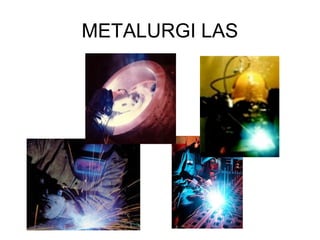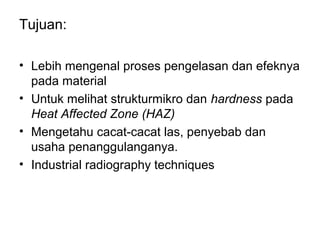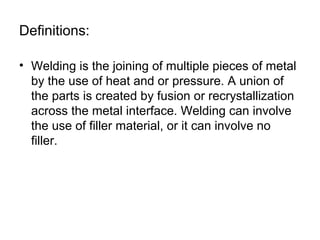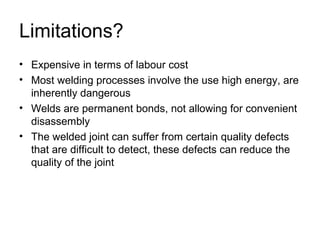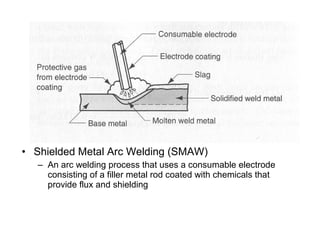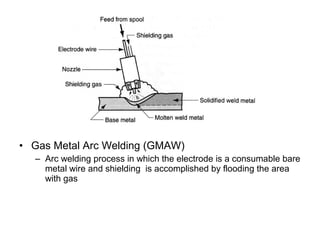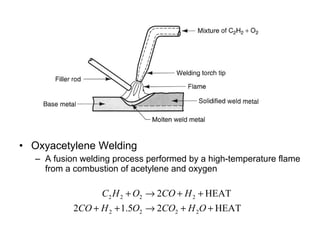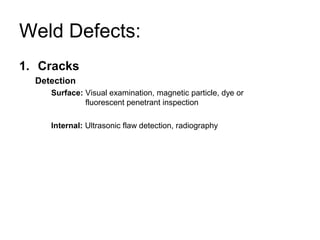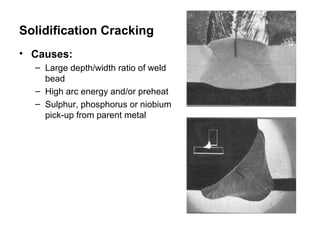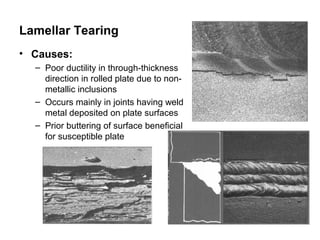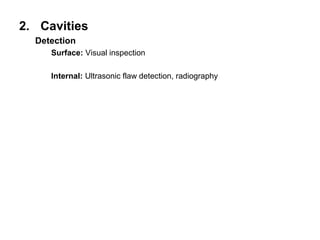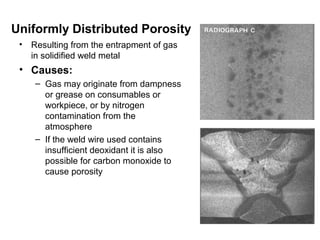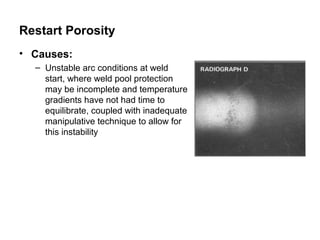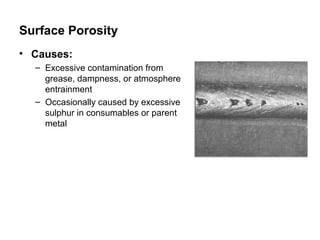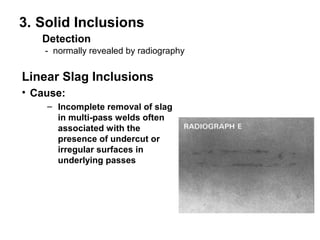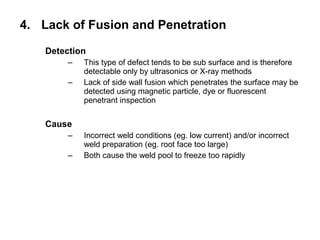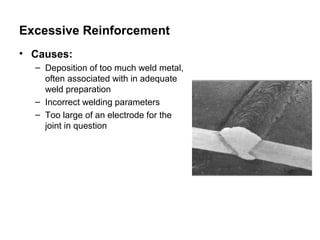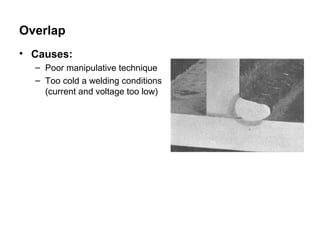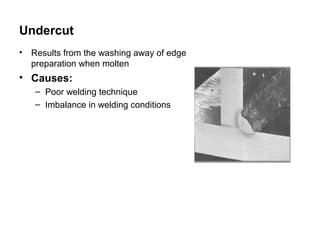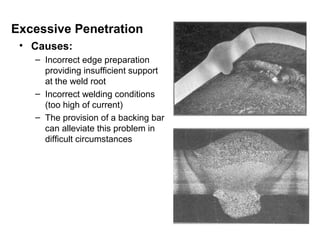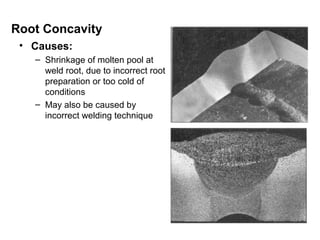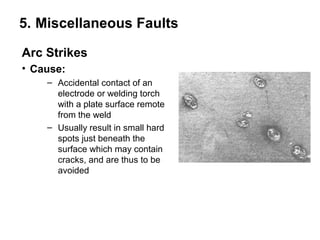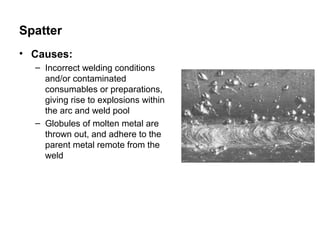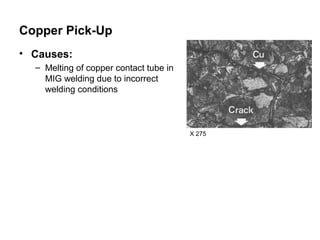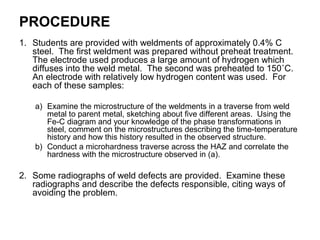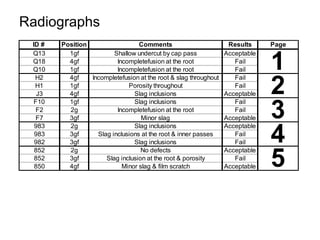Me 328 welding metallurgy
- 2. Tujuan: • Lebih mengenal proses pengelasan dan efeknya pada material • Untuk melihat strukturmikro dan hardness pada Heat Affected Zone (HAZ) • Mengetahu cacat-cacat las, penyebab dan usaha penanggulanganya. • Industrial radiography techniques
- 3. Definitions: • Welding is the joining of multiple pieces of metal by the use of heat and or pressure. A union of the parts is created by fusion or recrystallization across the metal interface. Welding can involve the use of filler material, or it can involve no filler.
- 4. What commercial and technological importance does welding have? • Provides a permanent joint • Weld joint can be stronger than parent material – If the filler material has superior strength characteristics and proper techniques are used • Usually the most economical way to join components • Can be done in the field away from a factory
- 5. Limitations? • Expensive in terms of labour cost • Most welding processes involve the use high energy, are inherently dangerous • Welds are permanent bonds, not allowing for convenient disassembly • The welded joint can suffer from certain quality defects that are difficult to detect, these defects can reduce the quality of the joint
- 6. Types: • Arc Welding – A fusion welding process in which the coalescence of the metals is achieved by the heat from an electric arc between an electrode and the work
- 7. • Shielded Metal Arc Welding (SMAW) – An arc welding process that uses a consumable electrode consisting of a filler metal rod coated with chemicals that provide flux and shielding
- 8. • Gas Metal Arc Welding (GMAW) – Arc welding process in which the electrode is a consumable bare metal wire and shielding is accomplished by flooding the area with gas
- 9. • Submerged Arc Welding – Arc welding process that uses a continuous, consumable bare wire electrode, arc shielding is provided by a cover of granular flux
- 10. • Resistance Welding – A fusion welding process that utilizes a combination of heat and pressure to accomplish coalescence, the heat being generated by electrical resistance to current flow at the junction to be welded
- 11. • Oxyacetylene Welding – A fusion welding process performed by a high-temperature flame from a combustion of acetylene and oxygen C2 H 2 + O2 → 2CO + H 2 + HEAT 2CO + H 2 + 1.5O2 → 2CO2 + H 2O + HEAT
- 12. Fusion Weld Joint • Fusion Zone – A mixture of filler metal and base metal that has completely melted – High degree of homogeneity among the component metals that have been melted during welding – The mixing of these components is motivated largely by convection in the molten weld pool
- 13. • Weld Interface – The narrow boundary that separates the fusion zone and the heat affected zone – This interface consists of a thin band of base metal that was melted or partially melted (localized melting within the grains) during the welding process, but immediately solidified before any mixing could take place • Heat Affected Zone (HAZ) – The metal in this region has experienced temperature below its melting point, but high enough to change the microstructure – This metal consists of the base metal which has undergone a heat treatment due to the welding temperatures, so that its properties have been altered. – The amount of metallurgical damage in the HAZ depends on the amount of heat input, peak temp reached, distance from fusion zone, time at elevated temp, cooling rate, and the metal’s thermal properties
- 14. • Heat Affected Zone (HAZ) cont’d – The effect on the mechanical properties is usually negative, and it is most often the region of the weld joint where failure occurs • Unaffected Base Metal Zone – Where no metallurgical change has occurred – The base metal surrounding the HAZ is likely to be in a state of high residual stress, due to the shrinkage in the fusion zone
- 15. Weld Defects: 1. Cracks Detection Surface: Visual examination, magnetic particle, dye or fluorescent penetrant inspection Internal: Ultrasonic flaw detection, radiography
- 16. Solidification Cracking • Causes: – Large depth/width ratio of weld bead – High arc energy and/or preheat – Sulphur, phosphorus or niobium pick-up from parent metal
- 17. Hydrogen Induced HAZ Cracking • Causes: – Hardened HAZ coupled with the presence of hydrogen diffused from weld metal – Susceptibility increases with the increasing thickness of section especially in steels with high carbon equivalent composition – Can also occur in weld metal – Increase welding heat beneficial – Preheating sometimes necessary – Control of moisture in consumables and cleanliness of weld prep desirable
- 18. Lamellar Tearing • Causes: – Poor ductility in through-thickness direction in rolled plate due to non- metallic inclusions – Occurs mainly in joints having weld metal deposited on plate surfaces – Prior buttering of surface beneficial for susceptible plate
- 19. Reheat Cracking • Occurs in creep resisting and some thick section structural low alloy steels during post weld heat treatment • Causes: – Poor creep ductility in HAZ coupled with thermal stress – Accentuated by severe notches X 35 such as preexisting cracks, or tears at weld toes, or unfused root of partial penetration weld – Heat treatment may need to include low temperature soaking – Grinding or peening weld toes after welding can be beneficial X 200
- 20. 2. Cavities Detection Surface: Visual inspection Internal: Ultrasonic flaw detection, radiography
- 21. Worm Holes • Resulting from the entrapment of gas between the solidifying dendrites of weld metal, often showing ‘herringbone’ array ( B ) • Causes: – The gas may arise from contamination of surfaces to be welded, or be prevented from escaping from beneath the weld by joint crevices
- 22. Uniformly Distributed Porosity • Resulting from the entrapment of gas in solidified weld metal • Causes: – Gas may originate from dampness or grease on consumables or workpiece, or by nitrogen contamination from the atmosphere – If the weld wire used contains insufficient deoxidant it is also possible for carbon monoxide to cause porosity
- 23. Restart Porosity • Causes: – Unstable arc conditions at weld start, where weld pool protection may be incomplete and temperature gradients have not had time to equilibrate, coupled with inadequate manipulative technique to allow for this instability
- 24. Surface Porosity • Causes: – Excessive contamination from grease, dampness, or atmosphere entrainment – Occasionally caused by excessive sulphur in consumables or parent metal
- 25. Crater Pipes • Resulting from shrinkage at the end crater of a weld run • Causes: – Incorrect manipulative technique or current decay to allow for crater shrinkage
- 26. 3. Solid Inclusions Detection - normally revealed by radiography Linear Slag Inclusions • Cause: – Incomplete removal of slag in multi-pass welds often associated with the presence of undercut or irregular surfaces in underlying passes
- 27. Isolated Slag Inclusions • Causes: – Normally by the presence of mill scale and/or rust on prepared surfaces, or electrodes with cracked or damaged coverings – Can also arise from isolated undercut in underlying passes of multi-pass welds
- 28. 4. Lack of Fusion and Penetration Detection – This type of defect tends to be sub surface and is therefore detectable only by ultrasonics or X-ray methods – Lack of side wall fusion which penetrates the surface may be detected using magnetic particle, dye or fluorescent penetrant inspection Cause – Incorrect weld conditions (eg. low current) and/or incorrect weld preparation (eg. root face too large) – Both cause the weld pool to freeze too rapidly
- 29. Lack of side-wall fusion Lack of root fusion Lack of inter-run fusion Lack of penetration
- 30. 5. Imperfect Shape Detection - all shape defects can be determined by visual inspections Linear Misalignment • Cause: – Incorrect assembly or distortion during fabrication
- 31. Excessive Reinforcement • Causes: – Deposition of too much weld metal, often associated with in adequate weld preparation – Incorrect welding parameters – Too large of an electrode for the joint in question
- 32. Overlap • Causes: – Poor manipulative technique – Too cold a welding conditions (current and voltage too low)
- 33. Undercut • Results from the washing away of edge preparation when molten • Causes: – Poor welding technique – Imbalance in welding conditions
- 34. Excessive Penetration • Causes: – Incorrect edge preparation providing insufficient support at the weld root – Incorrect welding conditions (too high of current) – The provision of a backing bar can alleviate this problem in difficult circumstances
- 35. Root Concavity • Causes: – Shrinkage of molten pool at weld root, due to incorrect root preparation or too cold of conditions – May also be caused by incorrect welding technique
- 36. 5. Miscellaneous Faults Arc Strikes • Cause: – Accidental contact of an electrode or welding torch with a plate surface remote from the weld – Usually result in small hard spots just beneath the surface which may contain cracks, and are thus to be avoided
- 37. Spatter • Causes: – Incorrect welding conditions and/or contaminated consumables or preparations, giving rise to explosions within the arc and weld pool – Globules of molten metal are thrown out, and adhere to the parent metal remote from the weld
- 38. Copper Pick-Up • Causes: – Melting of copper contact tube in MIG welding due to incorrect welding conditions X 275
- 39. PROCEDURE 1. Students are provided with weldments of approximately 0.4% C steel. The first weldment was prepared without preheat treatment. The electrode used produces a large amount of hydrogen which diffuses into the weld metal. The second was preheated to 150˚C. An electrode with relatively low hydrogen content was used. For each of these samples: a) Examine the microstructure of the weldments in a traverse from weld metal to parent metal, sketching about five different areas. Using the Fe-C diagram and your knowledge of the phase transformations in steel, comment on the microstructures describing the time-temperature history and how this history resulted in the observed structure. b) Conduct a microhardness traverse across the HAZ and correlate the hardness with the microstructure observed in (a). 2. Some radiographs of weld defects are provided. Examine these radiographs and describe the defects responsible, citing ways of avoiding the problem.
- 40. Radiographs ID # Position Comments Results Page 1 Q13 1gf Shallow undercut by cap pass Acceptable Q18 4gf Incompletefusion at the root Fail Q10 1gf Incompletefusion at the root Fail 2 H2 4gf Incompletefusion at the root & slag throughout Fail H1 1gf Porosity throughout Fail J3 4gf Slag inclusions Acceptable 3 F10 1gf Slag inclusions Fail F2 2g Incompletefusion at the root Fail F7 3gf Minor slag Acceptable 4 983 2g Slag inclusions Acceptable 983 3gf Slag inclusions at the root & inner passes Fail 982 3gf Slag inclusions Fail 5 852 2g No defects Acceptable 852 3gf Slag inclusion at the root & porosity Fail 850 4gf Minor slag & film scratch Acceptable

